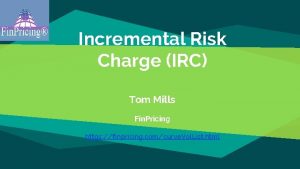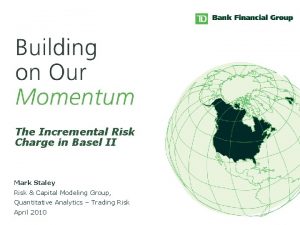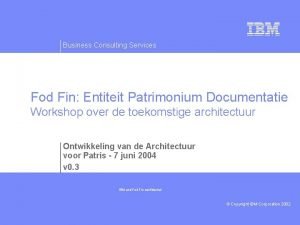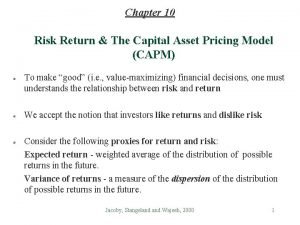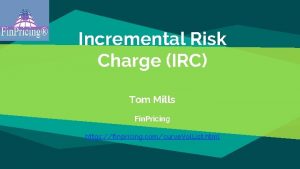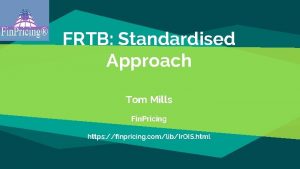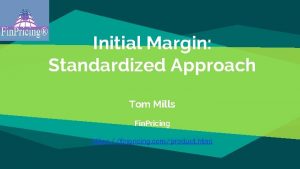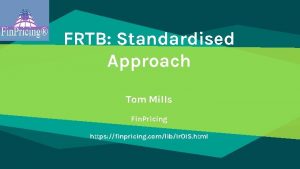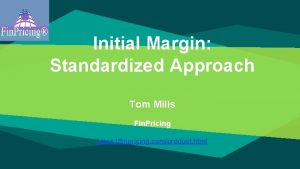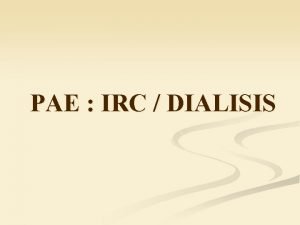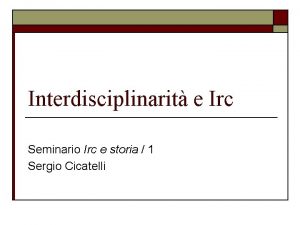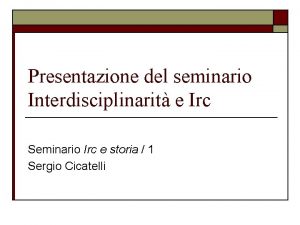Incremental Risk Charge IRC Tom Mills Fin Pricing












- Slides: 12

Incremental Risk Charge (IRC) Tom Mills Fin. Pricing https: //finpricing. com/curve. Vol. List. html

IRC Summary ◆ Market Risk Types ◆ IRC Definition ◆ IRC Scope ◆ IRC Main Features ◆ Default and Migration Simulation ◆ Constant level of risk ◆ Implementation

IRC Market Risk Types ◆ General market risk ◆ Idiosyncratic or specific risk: such as equity specific risk and debt specific risk ◆ Even risk (e. g. , default or migration): IRC is intended to capture even risk

IRC Definition ◆ The incremental risk charge (IRC) is a new regulatory requirement from the Basel Committee in response to the financial crisis. ◆ IRC supplements existing Value-at-Risk (Va. R) and captures the loss due to default and migration events at a 99. 9% confidence level over a oneyear capital horizon. IRC Scope ◆ Debt instruments are subject to IRC. ◆ Credit products, including structured credit, are included in IRC.

IRC Main Features ◆ Liquidity is explicitly modeled in IRC through liquidity horizon and constant ◆ level of risk. Constant level of risk assumption ◆ Hold portfolio constant over liquidity horizon ◆ Rebalance any default, downgraded, or upgraded positions at the beginning of each liquidity horizon ◆ Roll over any matured positions at the beginning of each horizon ◆ Default and migration need to be simulated for one-year horizon. ◆ Concentration measures the degree of a portfolio diversification. For example, if a significant number of issuers belong to a certain category, the portfolio is a concentrated one.

IRC ◆

IRC ◆

IRC Constant level of risk ◆ The constant level of risk reflects recognition by regulators that securities/derivatives held in the trading book are generally much more liquid than those in the banking book. ◆ We interpret constant level of risk as constant loss distribution, i. e. , ◆ The same loss distribution over each liquidity horizon ◆ The same rating over each liquidity horizon ◆ The same risk metrics over each liquidity horizon ◆ For example, the liquidity horizon for a portfolio is 3 months. That means the bank holds its portfolio components constant for 3 months and then rebalances it by replacing any default or downgraded or upgraded positions so that the portfolio is returned to the initial level of risk.

IRC Constant level of risk (Cont’d) ◆ The process is repeated four times to arrive at 1 -year shown as ◆ In Monte Carlo context, this can be modeled by drawing 4 times from the ◆ single-period loss distribution measured over the liquidity horizon. The advantages of this assumption ◆ Avoid the complexity of rebalancing and roll-over ◆ Reduce computation significantly

IRC ◆

IRC Implementation (Cont’d) ◆ Based on the constant level of risk assumption, the 3 -6 months, 6 -9 months and 9 -12 months loss distributions are just the copy of 0 -3 months lost distribution. ◆ The 1 -year loss distribution is the convolution of 4 copies of the first 3 month loss distribution. ◆ IRC = 99. 9% quantile of the 1 -year loss distribution

Thanks! You can find more online details at https: //finpricing. com/lib/irc. html
 Finpricing
Finpricing Incremental risk charge
Incremental risk charge Spf fin fod fin
Spf fin fod fin Prisme droit à base trapèze
Prisme droit à base trapèze Liquidity measures
Liquidity measures Go 910
Go 910 What does tom symbolize in the devil and tom walker
What does tom symbolize in the devil and tom walker Field of dreams
Field of dreams Difference between charge and electric charge
Difference between charge and electric charge Difference between charge and electric charge
Difference between charge and electric charge Capital market line
Capital market line Identifying and managing project risk tom kendrick
Identifying and managing project risk tom kendrick Java irc bot
Java irc bot
